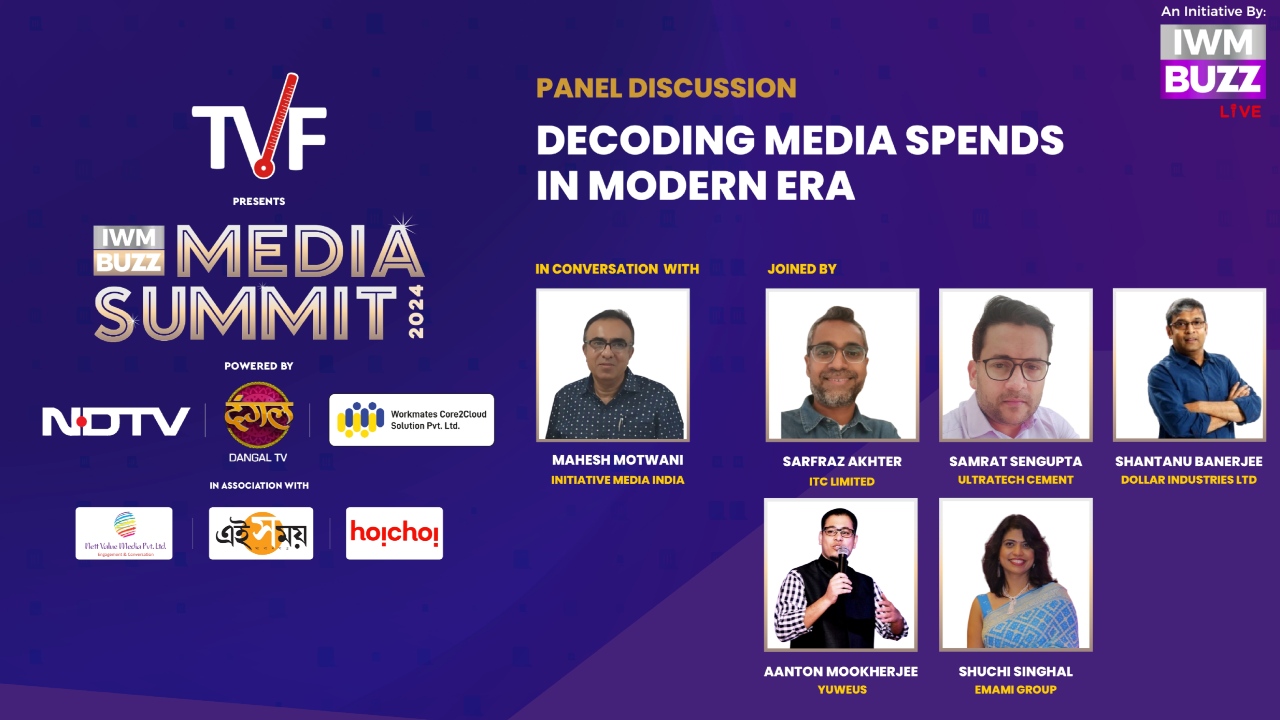The IWMBuzz Media Summit, held on November 14, 2024, at the Fairfield by Marriott in Kolkata, brought together some of the brightest minds from the media and advertising industries for an insightful and engaging panel discussion. The session titled “Decoding Media Spends in the Modern Era” explored the evolving dynamics of media consumption, content creation, and the strategic allocation of advertising budgets in today’s fragmented landscape.
The panel featured notable figures including Mahesh Motwani, Executive VP at Initiative Media India; Sarfaraz Akhter, Senior Media Manager at ITC Limited; Samrat Sengupta, AVP of Brand Building at UltraTech Cement; Shantanu Banerjee, General Manager of Marcom at Dollar Industries Ltd.; Aanton Mookherjee, Chief Idea Advisor at YUWEUS; and Shuchi Singhal, AVP of Media at Emami Group. Their discussion provided invaluable perspectives on the challenges and opportunities of navigating modern media spends.
Creative Content Dominates The Media Spend Equation
A key point of discussion was the growing shift from traditional media to creative content. Shuchi Singhal remarked that the relationship between media and creative content now skews heavily toward the latter—30% media and 70% creative. This shift reflects an industry-wide acknowledgment that, in today’s digital-first environment, compelling content is the driving force behind successful marketing campaigns. Television remains a key platform, but its role is becoming more about frequency and consistent engagement rather than mass reach.
Singhal’s assertion underscores the growing importance of creating content that not only attracts attention but holds it in an era where consumer focus is increasingly fragmented. With viewers inundated with choices, content needs to be distinctive and relevant to sustain their interest. The challenge, as Singhal noted, lies in capturing and maintaining attention amidst a sea of distractions.
Fragmented Media Landscape And Rise Of Influencer Marketing
The panel also discussed the increasing fragmentation of media, with Sarfaraz Akhter highlighting the overwhelming plethora of content choices that consumers now face. He described it as a double-edged sword: while an abundance of options theoretically increases the opportunity for engagement, it also diminishes the consumer’s attention span. In his view, the modern consumer’s “goldfish memory” results in fleeting interactions, which complicates marketers’ efforts to create lasting impressions.
One significant trend emerging from this fragmentation is the growing prominence of influencer marketing. Aanton Mookherjee emphasized the need for brand managers and agencies to collaborate closely to understand consumer behavior and tailor their marketing strategies accordingly. “The joy of watching is where the consumer is comfortable,” Mookherjee noted, pointing to the increasing preference for niche content and the rise of platforms like social media and OTT channels.
The panel agreed that influencer marketing, in particular, offers brands an opportunity to engage with specific communities, providing a more personalized and intimate way to connect with consumers. As Mookherjee pointed out, the key is to identify and engage with niche audiences rather than trying to capture a broad, undifferentiated market.
The discussion also turned to the importance of localization in media strategy. Samrat Sengupta of UltraTech Cement stressed the need for localized advertising, particularly in categories like cement, which traditionally falls outside the B2B space. Sengupta pointed out that advertising strategies must be personalized to cater to local consumers rather than taking a one-size-fits-all approach. This sentiment echoed the broader shift toward regionalization, where brands are tailoring their messaging to resonate with specific demographics, cultures, and geographies.
This emphasis on localization reflects a deeper understanding of the evolving consumer base, where preferences are shaped by regional identities and local context. In this environment, traditional methods of mass communication are being supplanted by more personalized, targeted strategies that speak to the individual consumer’s needs and desires.
The current role of television in a digital-first world-
Despite the clear trends toward digital and OTT platforms, the panel maintained that television still holds significant value in media planning. Shantanu Banerjee likened media strategists to classroom teachers, responsible for guiding the allocation of budgets to the most impactful channels. However, he acknowledged the increasing complexity of this task due to the diverse media options available. Banerjee noted that the reach and impact of television ads, particularly those tied to major programs like The Kapil Sharma Show, continue to deliver substantial returns on investment.
This point was countered by Suchi Singhal, who argued that while television remains important, its influence is waning. She cited the movement of traditional television content to platforms like Netflix as evidence of changing viewing habits. “Television is not working as it once did,” Singhal remarked, highlighting the need for brands to adjust their strategies to reflect the shifting dynamics of media consumption.
Looking Ahead: What is the future of media spending?
The discussion concluded with a forward-looking perspective on media spends. Mahesh Motwani highlighted that future spending would be heavily influenced by consumer trends, emphasizing the need for marketers to stay agile and adapt to rapid changes in consumer behavior. Shantanu Banerjee echoed this sentiment, noting that the market is in constant flux, and strategies must evolve accordingly. “Target segments are constantly changing,” he said, “and brands must embrace experiential marketing to connect with the younger, more dynamic consumer.”
As the panel wrapped up, the overarching takeaway was on the pick: the future of media spending is deeply intertwined with an understanding of the consumer’s evolving preferences.
Marketers must invest in creative, localized, and influencer-driven strategies while balancing traditional media with new-age digital platforms. Only by staying attuned to these shifts can brands ensure they remain relevant in an increasingly fragmented media terrain.
Title Partner: TVF
Powered by: NDTV | Dangal TV | Workmates Core2Cloud Solution Pvt. Ltd.
In Association with: Nett Value Media Pvt. Ltd. | Ei Samay | Hoichoi
Partners: Taarak Mehta Ka Ooltah Chashmah Rhymes | Redington Limited | White Frames | Just Lateral ThinkInk | Celebistaan | Decalogue
Watch the full video below:

